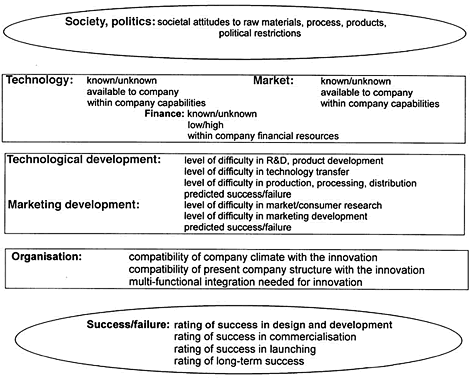FOOD
PRODUCT DEVELOPMENT
Mary Earle, Richard Earle and Allan Anderson |
| Loading
|
|
||||
|
|
Part 2, Chapter 2
Developing an innovation strategy 2.4.3 Strategic and operational analysis
This is a very important step in ensuring that innovation can be successful in the company. It is the time when the people to be involved in the projects are brought together with the people who have been developing the business strategy and the innovation strategy. It is both a creative and an analytical exercise. The creative abilities of the designers and developers will start giving 'flesh' to the innovation strategy. The outcomes of the various sub-innovation strategies and then the innovation strategy as a whole need to be predicted.
This needs to be an interactive, multifunctional, multidisciplinary activity in the company, so that the various departments and people who are going to be involved in the projects are knowledgeable about the strategies and have been involved in prioritising them. There may be a need for consultants to provide information and for facilitators to conduct the discussion but this has to be an internal, creative activity. The company group as a whole needs to feel that it has been involved in developing the innovation strategies so that they will take them on enthusiastically through the next stages. The Board members need also to be involved in some of the discussions so that they have an understanding of the knowledge and the abilities for innovation in the company. They also indicate where the company is focused for the future and the goals that they see the company has to achieve. Such an interactive building of innovation strategies can be simple in the small company - it probably does it continuously over cups of coffee or pints of beer. But even a small company must do it formally at least once a year. In the larger companies, it may be more difficult but with interactive computer systems the discussions can evolve without too many large meetings. For major strategy changes, this identification and ranking of the innovation possibilities can take some time. It is essentially a creative process followed by an analytical step, which is reiterated time and time again. Everyone needs to have the same interpretation of the proposed innovation strategy and the necessary outcomes. For ranking, various techniques may help from simple scoring on the ranking factors, to use of the Delphi method. Again there needs to be discussion on differences in the scores, and re-scoring until agreement is reached. Some factors to study in the combined discussions are shown in Fig. 2.9.  Fig. 2.9 Factors for discussions on innovation strategies. It is important to identify innovations that:  will fail; will fail;
 cannot be accommodated in the company; cannot be accommodated in the company;
 will need an effort beyond the resources of the company; will need an effort beyond the resources of the company;
 will take too long to complete or have an indeterminate end point; will take too long to complete or have an indeterminate end point;
 will cause a problem because there is not the necessary integration of will cause a problem because there is not the necessary integration of design, production, marketing. It is also important to identify innovations where the technology is uncertain, or where the transfer from basic or strategic research to development needs advanced and difficult technological research. Predicting the outcomes of the innovation strategy, in particular the prediction of success, may be intuitive and subjective at this stage. But of course there are levels of success that will need to be predicted if decisions are to be made on the projects. Both the resources available and changes in the environment will affect the outcome of the innovation - changing a probable success into an actual failure. So the important success targets for the company are identified, and then the external and internal environments. The individuals in the group make predictions on the outcomes for each success measure. They may be subjective descriptions such as: Complete dud - Doubtful - Should be OK - Probable success- Out-of-this-world Or on scales: Definitely a failure _________________________________ Definitely a success Alternatively the Q sort method can be used in which a set of cards, one for each individual strategy, is given to each group member. Group members sort them individually into five categories from definitely a success to definitely a failure, or just into two categories - Yes, a success/ No, a failure (Green et al., 1988). It is important after each rating of the company measures to show the participants all the scores, and then to repeat the scoring. If the scores are widely different and consensus is not being reached, then further discussions need to be held. It is important not to do just a success or failure for the overall innovation, but to do it on the individual measures to see where differences are occurring. The problems in these subjective measures are that some innovations, which could be successful, are dropped and that some failures are carried on. It is better at this preliminary stage to give the project the benefit of the doubt and keep it in for the later stages. Another problem might be that all the projects are mediocre, but one feels that as they are ranked, the top five should be chosen. It is very important to be critical and to recycle rather than go on. It is much cheaper to recycle than to take below-standard strategies on to the next more expensive stages. Maybe you need other people in the group to give more creative and useful ideas!
|
|
 |